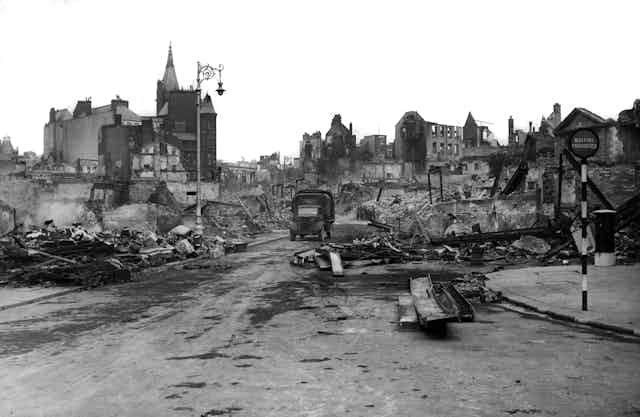Its Friday evening and I’m sitting waiting for a bomb to sail past me. This isn’t a regular Friday and I can no longer feel my toes or fingers as I sit in the gathering gloom in the gardens of Admiralty House, overlooking the river Tamar, close to the Devonport Naval Base.
Four days previously, on Tuesday, February 20 2024, a builder working on a house extension in the Keyham area of Plymouth, on England’s south coast, began to take an interest in a corroded lump of metal he’d recently exposed.
Initially it looked like an old pipe or boiler that someone had buried in the back garden. But it was raining. As the wet soil fell away from “the pipe”, the dimensions and shape resolved into what would prove to be a second world war-era, SC500, high-explosive, air-dropped munition.
That’s a 500kg bomb to you and me. It was dropped there by the German Luftwaffe, most likely in the heavy raids the city was subjected to in March-April 1941.
Plymouth, where I have taught for 20 years, was home to the Devonport naval base. This put it high on the list of targeting priorities for the German Air Force and Navy in 1941.
Between March and April of that year, German forces launched deadly raids against Plymouth. Thousands of munitions, ranging from 1kg incendiaries to 1,000kg high-explosive bombs, rained down on the city. They razed the city centre, destroying and damaging over 20,000 homes and killing almost 1,200 Plymouthians.
Eighty three years later, the local Royal Navy Unexploded Ordnance Team – the Bomb Squad – confirmed that a bomb had indeed been found in the terraced streets behind the dockyard. A remarkably efficient operation immediately swung into action. This involved Royal Navy and Army explosives experts, the police, the emergency services, the local council, its workers and other volunteers, together with the residents of the city.
This has happened before in Plymouth. Every year the occasional bomb is found in those cities across Britain that were blitzed during the second world war.

War-time history
Just the week before the Keyham bomb was discovered, I had taken my history students to the Box, Plymouth’s local museum, to look at the Blitz records held there. The Plymouth Bomb Book, in particular, makes for sobering reading.
This book features a map of the city dotted with red for all the places where high-explosive bombs are known to have fallen – the visual equivalent of a city stricken with an outbreak of war-related measles. The war would leave its mark on the city. New houses would come to break up older blocks. Whole districts would be destroyed and cleared away and a city centre redeveloped according the 1943 Plan for Plymouth.
Despite the devastation essential services were quickly restored. The vitally important dockyard continued to function. The city picked itself up even as the dead were buried. The rubble that had formerly been shops, offices and homes was tidied into orderly mounds to await removal.
But the war also fostered a feeling among local residents that however good the new post-war Plymouth looked, it could never approach the grandeur of what was lost in 1941.
An efficient handling
As the city was rebuilt in the 1950s and 1960s, the occasional unexploded bomb left beneath the surface would emerge. The Keyham bomb lay undisturbed for more than 80 years.
Its age and its situation in a dense urban environment, meant that by Thursday, February 22, the exclusion zone around the bomb site had extended from 200 metres to over 300 metres. Over 1,200 properties were vacated; 3,250 people found temporary accommodation.
Family and friends, emergency centres, and local hotels were drawn into a mass civilian evacuation. It was remarkably good humoured, and efficiently handled by the authorities, Plymouthians demonstrating the kind of stoicism that their forbears had shown in 1941.
In the city there was a sense that people understood what was at stake for householders whose homes were at risk and for the teams charged with dealing with the emergency. Plymouth, after all, is a city fully aware of its wartime heritage.
With any attempt to blow up the bomb in situ likely to result in the destruction of not one, but several properties, an ambitious plan was hatched. The goal was to extract it and transport it, via road, to get it out to sea.
On Friday, February 23, people living along the route were notified by both government emergency message (its first use in a real emergency in the UK) and by the local media that they had to leave their homes. Everyone did so calmly and efficiently. Homes emptied. Businesses shut down early.
It took 20 minutes for the bomb to be gingerly lifted from its muddy resting place and transported by lorry to the water’s edge. Once at the river Tamar, which flows into the Hamoaze river before joining Plymouth Sound, the bomb was loaded on to a vessel and escorted, by Ministry of Defence police at a distance, out to sea.
It was a protracted process. In the cold and occasional rain, we waited and waited. Our thoughts were with the driver of the lorry and with the crews involved in getting it out to sea.
The bomb sailed quietly past my position then transited the sound, out to beyond the breakwater. As it was lowered to the ocean floor, to await disposal by explosion, you could almost hear the sounds of a city breathing out in relief. You sensed too, a certain civic pride in a challenge well handled.
Shortly before 10pm, in the February darkness, the bomb was exploded in its watery grave. The episode that had begun with high drama, four days earlier, ended in a gentle whimper that most people in the city didn’t hear.

